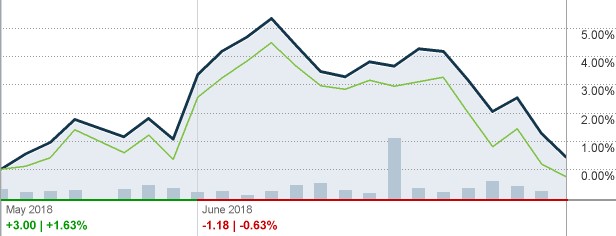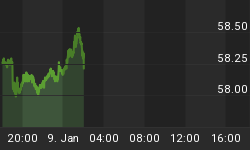Semiconductor chip stocks have been red-hot since the beginning of 2016, taking out new all-time highs—until now. While they tend to be cyclical with alternate boom-bust cycles, they’ve just shifted into reverse gear, thanks to the U.S.-China trade war.
If you look at chip stocks since the beginning of the year, and until last week, you would have seen three times the 3-percent the S&P 500 managed to muster over the same timeframe. Popular industry benchmarks iShares PHLX Semiconductor ETF (SOXX) and VanEck Vectors Semiconductor ETF (SMH) were sitting on YTD returns of 9.72 percent and 9.0 percent, respectively.
But all of a sudden the sector seems to have developed cold feet. After seven consecutive weeks of nice gains, chip stocks have not only run out of steam but are effectively in reverse gear, with both SOXX and SMH slipping nearly five percent over the past two weeks.
iShares PHLX Semiconductor ETF(SOXX) vs. VanEck Vectors Semiconductor ETF(SMH) 30-Day Change

(Click to enlarge)
Source: CNN Money
There’s no industrywide news that could have caused the slide, so all fingers point to one direction—trade wars, specifically those between the U.S. and China. After a two-month ceasefire, the U.S. and China has opened a renewed round of war of words on tariffs sending stocks in the sector tumbling.
At an industry average of 52 percent, semiconductor chip and semiconductor equipment companies have the highest revenue exposure to China of any U.S. industry.
Mobile chip manufacturers Skyworks Solutions, Qorvo and Qualcomm have the highest exposure to China, deriving 85 percent, 75 percent and 69 percent of their revenues in the country, respectively.
Meanwhile, Nvidia’s exposure clocks in at 56 percent, Intel at 40 percent and Advanced Micro Devices at 26 percent. Even mighty Apple has a relatively high exposure of 22 percent.
This leaves these companies highly vulnerable to any turmoil in the Middle Kingdom.

(Click to enlarge)
Source: CNBC
Buy Software Stocks
Although minor pullbacks are quite common during bull markets, large declines of five percent or more could usher in a bear market. However, it would be unwise to get rid of semiconductor stocks on account of trade spats between the U.S. and China.
Related: Trade War Fears Fail To Spook Legendary Investors
Semiconductor chips are indispensable in our modern world and will only continue playing an even more pivotal role in the economy as the years roll on. Graphic chip stocks like Nvidia (29.7 percent YTD return) and AMD (53.7 percent YTD return) in particular have been on a tear mainly because they are highly specialized, face little competition and their chips remain in high demand.
It’s a good idea to balance out your chip hardware exposure with software stocks.
The broad software industry has been doing exceptionally well as evidenced by the robust returns by leading ETFs in the space including PSJ (23.9-percent YTD return), XSW (19.5-percent YTD return) IGV (20.1 percent YTD return) and HACK (19.5-percent YTD return).
Secular trends like cloud computing (SKYY ETF), artificial Intelligence and virtual reality are likely to remain hot for years to come. Cloud computing might now seem like old news and not as sexy as AI and VR, yet companies in the industry are still providing juicy returns including Salesforce.com (32.1 percent YTD return), Workday (21.2 percent YTD return) and Cornerstone OnDemand (40.4 percent YTD return). These are trends that are likely to be around for years to come making these stocks good for the long haul.
So, beware the geopolitical, global trade rumblings that are taking the shine out of chip stocks—for now—but don’t run for the hills, just balance your exposure and stay the course.
By Alex Kimani for Safehaven.com
More Top Reads From Safehaven.com:

















